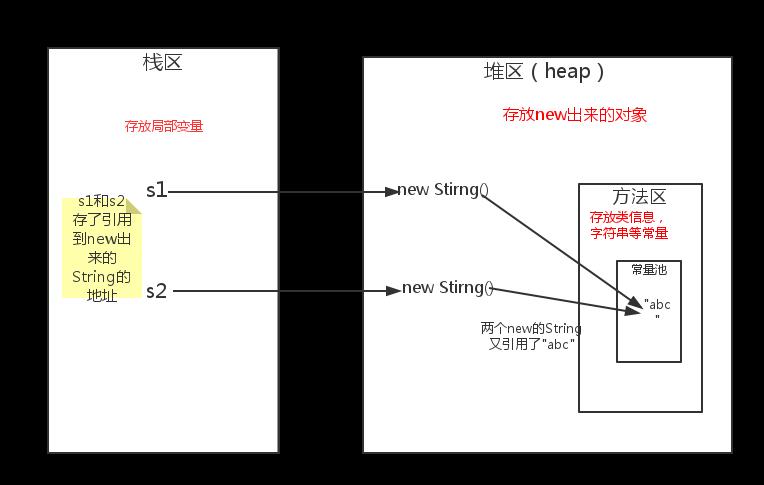Java String的点滴1
Posted
tags:
篇首语:本文由小常识网(cha138.com)小编为大家整理,主要介绍了Java String的点滴1相关的知识,希望对你有一定的参考价值。
先来说说String特点
String是不可变的常量,每当我们创建一个字符串对象的时候,如果堆区的常量池里不存在这个字符串,就会创建一个存储在常量池里(String存的地方叫String pool),如果存在了,就直接把变量的地址指向常量池里,比如:String b = “abc” 这句话 内存表示如下。下面开始上题
1.1
String s1 = new String("abc");
String s2 = new String("abc");
System.out.println(s1 == s2);输出结果是什么呢?
从上面的图也大概说了jvm里面有堆、栈区。==对于对象类型比较的是地址。所以在s1和s1是分别引用了堆里面new出来的不同对象的地址,图形理解如下

答案很明显了,地址不同 输出false.
1.2
String s1 = "abc";
StringBuffer s2 = new StringBuffer(s1);
System.out.println(s1.equals(s2));这是true 还是false呢?答案是false。
首先s1变量引用了字符串”abc”,然后StringBuffer s2 = new StringBuffer(s1),新建了一个StringBuffer对象调用append()方法返回自身。调用String的equals方法。重点就是这个equals方法里有个instance of,必需是同一类型的才进行比较否则直接返回false。
来看一下源码:
/**
* Compares this string to the specified object. The result is {@code
* true} if and only if the argument is not {@code null} and is a {@code
* String} object that represents the same sequence of characters as this
* object.
*
* @param anObject
* The object to compare this {@code String} against
*
* @return {@code true} if the given object represents a {@code String}
* equivalent to this string, {@code false} otherwise
*
* @see #compareTo(String)
* @see #equalsIgnoreCase(String)
*/
public boolean equals(Object anObject) {
if (this == anObject) {
return true;
}
//关键点就在这里了
if (anObject instanceof String) {
String anotherString = (String) anObject;
int n = value.length;
if (n == anotherString.value.length) {
char v1[] = value;
char v2[] = anotherString.value;
int i = 0;
while (n-- != 0) {
if (v1[i] != v2[i])
return false;
i++;
}
return true;
}
}
return false;
}
1.3
下面的代码在内存会产生几个对象呢?
String s1 = new String(“abc”);
String s2 = new String(“abc”);
答案:3个
有了上面的分析,相信大家都明白了,new了两个对象,加上string pool里的一个”abc”。
以上是关于Java String的点滴1的主要内容,如果未能解决你的问题,请参考以下文章
java.lang.NullPointerException: Attempt to invoke virtual method ‘int android.database.sqlite异常(代码片段
Failed to convert property value of type ‘java.lang.String‘ to required type ‘int‘ for property(代码片段